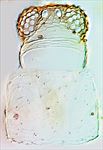Generic diagnosis
Female macropterous. Head with cheeks constricted behind large eyes, ocellar area reticulate; maxillary palps 3-segmented; compound eyes without pigmented facets; ocellar setae minute, pair III within the triangle; mouth cone pointed. Antennae 8-segmented, segment I without paired dorso-apical setae, III and IV with slender forked sense cone; III–VI with microtrichial rows on both surfaces; VII and VIII slender. Pronotum faintly reticulate; posterior margin with 4 pairs of short setae. Mesonotum with anterior campaniform sensilla; median setae arise in front of margin. Metanotum reticulate, median setae distant from anterior margin; without campaniform sensilla. Fore wing slender; first vein with several widely-spaced small setae, second vein without setae; clavus with 4 veinal and one discal setae. Prosternum without discal setae, ferna not divided but slender medially, prosternal spinasternum broad. Mesosternum with spinula, metasternum without spinula. Mid and hind tarsi 2-segmented. Tergites II–VIII reticulate, without craspeda, median setae small but not close together; VIII with no comb; IX with anterior campaniform sensilla, two pairs of posteromarginal setae with flattened, fringed apices; X with incomplete longitudinal split. Sternite VII median marginal setae arising in front of margin.
Biological data
The species of this genus seem to be associated with the fronds of certain ferns. The second species in the genus, nakaharai, has been found breeding on the fronds of Polypodiaceae species in Japan (Okajima & Urushihara, 1994).
Distribution data
One species in the genus is known only from Japan, and although seshadrii was described from southern India (Wilson, 1975) it has now been recorded from the Hawaiian Islands (Mound et al., 2017), from northeastern Australia (Mound & Tree. 2020), and from Jiangxi Province in southern China (Zhang et al. 2018).
Nomenclatural data
Indusiothrips Priesner, 1952: 183. Type species Indusiothrips seshadrii Priesner, 1952, by monotypy.
Only two species are recognised in this genus (ThripsWiki 2020), and one of these has been found in China:
seshadrii Priesner, 1952: 183
Relationship data
Thripidae sub-family Thripinae: this is a diverse group involving more than 230 genera. This genus, together with Isunidothrips, is considered to be related to Dendrothripoides, these three thus forming a group of uncertain relationships. In general appearance, Isunidothrips is particularly similar but the setae on tergite IX are pointed, and the fore wing second vein bears several setae.
References
Mound LA, Matsunaga J, Bushe B, Hoddle MS & Wells A (2017) Adventive Thysanoptera Species on the Hawaiian Islands: New Records and Putative Host Associations. Proceedings of the Hawaiian Entomological Society 49: 17–28.
Mound LA & Tree DJ (2020) Thysanoptera Australiensis – Thrips of Australia. Lucidcentral.org, Identic Pty Ltd, Queensland, Australia. https://keys.lucidcentral.org/keys/v3/thrips_australia/index.html
Okajima S and Urushihara H (1994) Rediscovery of Indusiothrips nakaharai Wilson from Japan (Thysanoptera, Thripidae). Transactions of the Shikoku Entomological Society 20: 97–101.
ThripsWiki (2020). ThripsWiki - providing information on the World's thrips. <http://thrips.info/wiki/Main_Page>
Wilson TH (1975) A monograph of the subfamily Panchaetothripinae (Thysanoptera: Thripidae). Memoirs of the American Entomological Institute 23: 1–354.
Zhang SM, Wang ZH, Li YJ & Mound LA (2018) One new species, two generic synonyms and eight new records of Thripidae from China (Thysanoptera). Zootaxa 4418 (4): 370–378.

